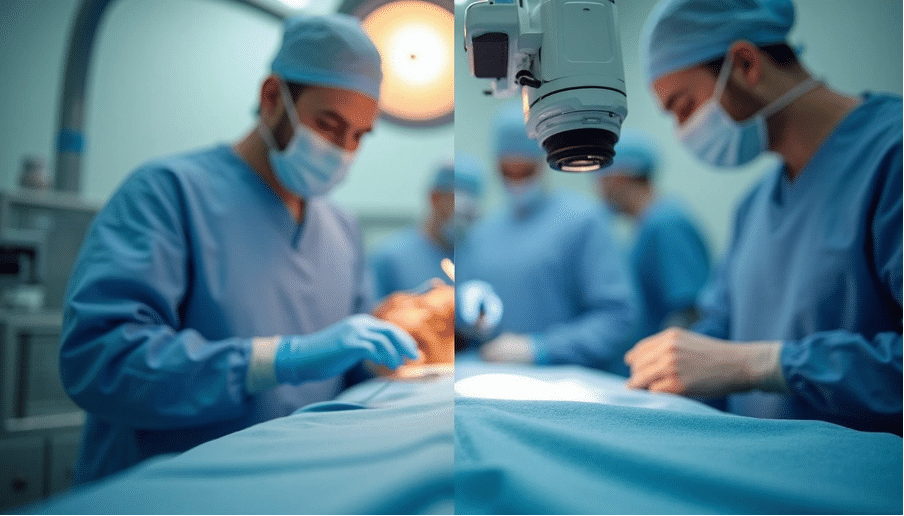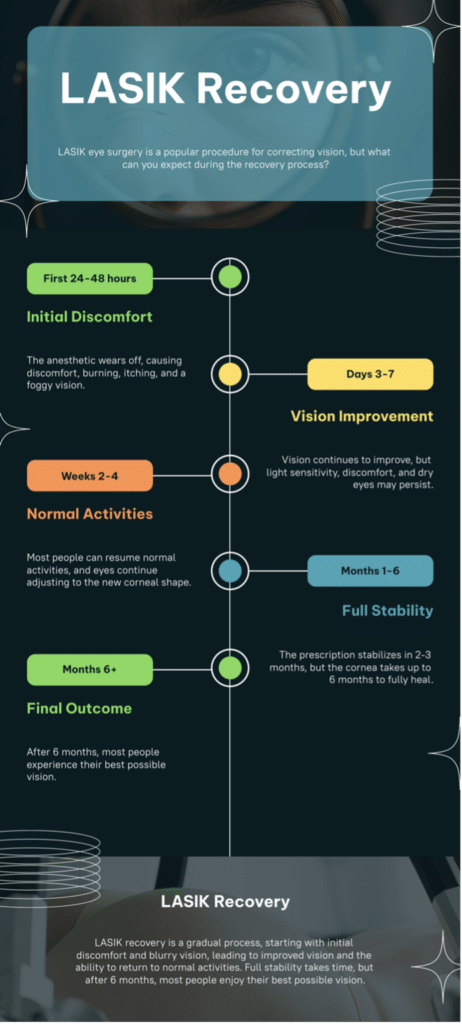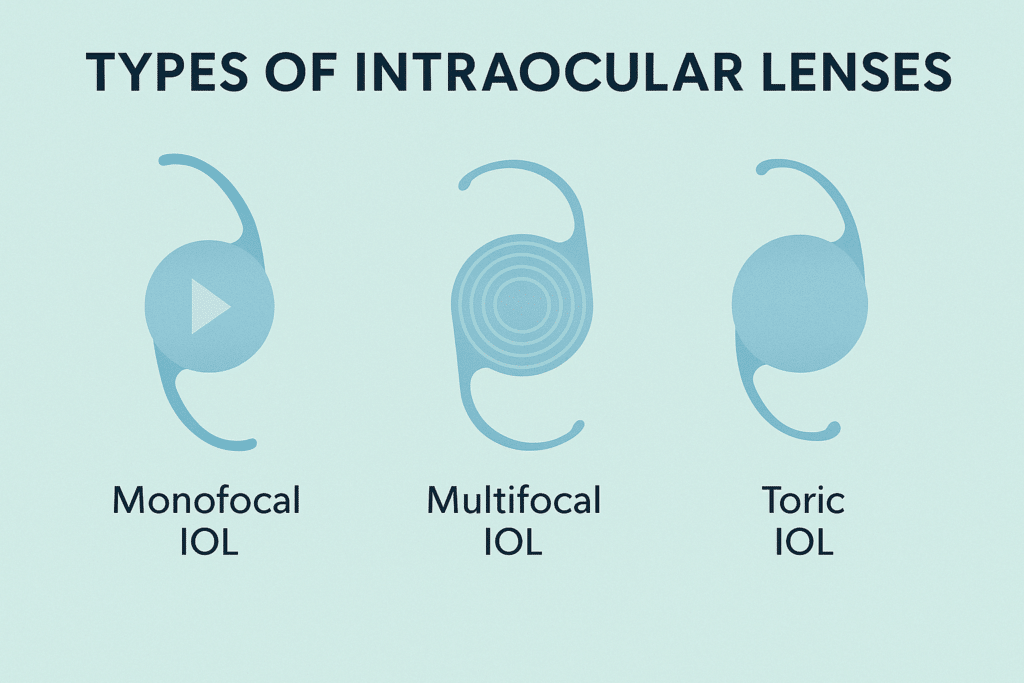Looking to ditch your glasses and contact lenses? You might be weighing your options between LASIK and lens replacement. Laser vision correction stands as one of the most popular treatments to improve eye health, with doctors performing over 700,000 LASIK procedures every year. But refractive lens exchange (RLE) has become a strong alternative, especially when you have patients over 40.
These procedures are quite different from each other. LASIK reshapes your cornea and takes just 5-10 minutes per eye. Lens replacement surgery is a big deal as it means that doctors remove your eye’s natural lens and put in an artificial intraocular lens (IOL). This process needs about 15-20 minutes per eye. The costs are different too. LASIK prices range from £1,000 to £4,000 per eye, while RLE with a standard implant costs around £3,800.
Both treatments correct nearsightedness, farsightedness, and other vision problems. Your best choice between LASIK eye surgery and lens replacement depends on factors like your age, eye health, and what you want to achieve. This complete guide gets into the main differences between these procedures to help you make the right choice for your vision correction experience.

How LASIK and Lens Replacement Work
Understanding how lasik vs lens replacement works helps you make better decisions about your vision correction options. These procedures use completely different methods to improve your eyesight.
LASIK: reshaping the cornea with laser precision
LASIK (Laser-Assisted In Situ Keratomileusis) reshapes your cornea—the transparent, dome-shaped surface at your eye’s front. Your cornea is a vital part that focuses light onto your retina. Blurred vision occurs when your cornea’s shape becomes irregular and bends light incorrectly.
Your surgeon uses a special cutting laser to create a thin corneal flap. They fold back this flap and use a programmed laser to remove tiny layers of corneal tissue. This reshapes the cornea to fix vision problems. The flap goes back in place and heals naturally without stitches.
LASIK treats three common vision problems:
- Nearsightedness (myopia) – distant objects look blurry
- Farsightedness (hyperopia) – close objects look blurry
- Astigmatism – everything looks blurry due to an irregular cornea shape
Lens replacement: implanting an artificial intraocular lens
Lens replacement surgery (also called Refractive Lens Exchange or RLE) takes a different path. This procedure removes your eye’s natural lens and puts in an artificial intraocular lens (IOL). The surgery starts with a tiny incision that heals by itself. Your surgeon uses phacoemulsification to break down your natural lens with ultrasound waves. They liquefy the pieces and suction them out. The new IOL fits through the same small cut.
Today’s IOLs come in several types:
- Monofocal lenses focus at one distance (near, intermediate, or far)
- Multifocal lenses give clear vision at multiple distances
- Toric lenses fix astigmatism
Surgical duration and recovery timelines
LASIK moves quickly and takes just 5-10 minutes per eye. You can get both eyes treated on the same day. The surgeon uses numbing eye drops, so you stay awake but comfortable. Lens replacement needs about 15-20 minutes for each eye. RLE procedures happen on different days, usually with a one to two-week gap between eyes. You get local anaesthetic and mild sedation during the surgery.
LASIK patients see better within days, but full stability takes 2-3 months. Most people return to work after 1-2 days. With lens replacement, vision starts clearing in a couple of days and stabilises in 2-4 weeks. You can resume normal activities, including light exercise and computer work, after about two weeks. The artificial lens lasts a lifetime and permanently fixes vision problems.
Age and Eye Health: Key Factors in Choosing a Procedure
Your age plays a key role in deciding between lasik vs lens replacement surgery. Eyes change throughout life, so this affects which procedure will give you the best results based on your vision needs.
Why LASIK is ideal for younger patients
If you have between 18 and 40 years, LASIK usually gives excellent results. The FDA has approved LASIK for people 18 years and older. Most surgeons suggest waiting until 21 years old to make sure your prescription stays stable. People in their 20s and 30s usually get the best results because their vision has stabilised, which helps doctors get a full picture of vision problems.

Young adults who are short-sighted, with or without astigmatism, find LASIK works really well. They haven’t developed presbyopia yet (the age-related problem focusing on close objects), so LASIK lets them keep their natural ability to see both near and far. Their corneal thickness and overall eye health usually make them perfect candidates for the procedure.
RLE as a preferred option for patients over 40
Vision changes become more noticeable once you hit your 40s. Presbyopia and early signs of lens clouding can substantially impact daily life. Refractive lens exchange (RLE) becomes the better choice at this age for several good reasons.
RLE fixes presbyopia, which LASIK can’t handle. LASIK works on the cornea instead of the lens, so it can’t stop the natural lens from hardening and causing reading problems. RLE also stops cataracts from developing by putting in a new lens.
RLE offers even more benefits after 50. Middle-aged patients often need reading glasses plus distance correction—something RLE with multifocal lenses can fix in one go. Patients over 60 often show early signs of cataracts, which makes lens replacement surgery the smart choice.
Conditions that may disqualify you from either surgery
Some eye and health conditions might rule out these procedures:
- For LASIK: Keratoconus, severe dry eye syndrome, pregnancy, thin corneas, unstable vision prescription, cataracts, and autoimmune diseases
- For RLE: Macular degeneration, advanced glaucoma, unstable vision, severe dry eye syndrome, and certain retinal conditions
Diabetes can make both procedures tricky, especially with poor blood sugar control, since it can cause vision changes and healing issues. On top of that, patients expecting miracles might not be the best candidates for either surgery.
LASIK or lens replacement? The right choice depends on your age, prescription, and eye health. Get expert advice at Precision Vision London—book your consultation now to find the best option for your vision.
Comparing Visual Outcomes and Long-Term Results
The visual outcomes between lasik vs lens replacement are a vital consideration that goes beyond just getting rid of your glasses. Both procedures give great results, but each has its strengths based on your eye condition.
Correcting distance, near, and astigmatism
Lens replacement surgery produces remarkable results for multiple vision problems. Studies show that 95% of patients achieve vision of driving standard or better after the procedure. This high success rate works for refractive errors of all types. Patients with astigmatism and those whose prescriptions don’t fit the normal range for laser eye surgery can benefit from this procedure.

Precision Vision London offers these IOL options:
- Monofocal lenses give clear vision at one distance (usually far)
- Multifocal lenses let you see clearly at multiple distances
- Toric lenses specifically fix astigmatism
Notwithstanding that, each lens type needs careful thought. Multifocal IOLs might create glare and halos around lights. Some patients barely notice these effects while others find them more challenging.
Presbyopia and cataract prevention with RLE
Lens replacement’s standout feature is knowing how to tackle presbyopia—the age-related problem that makes it hard to focus on close objects. RLE treats this condition by replacing your natural lens with an artificial one, something LASIK can’t do.
The procedure replaces your natural lens completely, which means you’ll never develop cataracts. This benefit makes lens replacement particularly valuable for patients over 40. They get better vision now and protect their eye health for years to come.
LASIK regression and enhancement potential
Of course, LASIK delivers excellent original results. Research shows some changes might happen over time. The largest longitudinal study found that 66.7% of LASIK patients had myopia greater than 1 diopter ten years after surgery. LASIK patients’ average myopic change was -1.09D during the 10-year follow-up period.
These factors affect how much vision might change:
- Higher original refractive error
- Smaller optical zone during surgery
- Patient’s age
RLE results stay stable because artificial lenses don’t change over time. A Precision Vision London expert explains, “The durable artificial lenses implanted in surgery don’t age, so patients enjoy clear lasting vision while avoiding cataracts.”
Book a consultation with our specialists at Precision Vision London to learn about which procedure fits your vision needs best.
Risks, Side Effects, and Recovery Experience
The benefits of vision correction are important, but you need to think about potential side effects too. Your recovery trip will differ based on which procedure you choose.
Common LASIK side effects: dry eyes, glare, halos
Dry eyes top the list of side effects after LASIK. This affects about 60-70% of patients. The condition happens because the procedure affects corneal nerves during flap creation. Our team at Precision Vision London gives you specialised lubricating drops in your aftercare package to help manage this issue.
Light scatter effects show up as glare, halos, and starbursts around lights. These are common, especially when you drive at night. Your eyes might show these effects because of corneal swelling during healing, but they usually go away within three months. Our experienced consultants help patients manage these mild effects with proper guidance.
RLE risks: retinal detachment, IOL dislocation
RLE comes with its own set of risks. Retinal detachment is a serious issue that happens more often in patients with high myopia and naturally thinner retinas. The artificial lens can move out of position in about 0.2-3% of cases. This rare complication can show up anywhere from days to years after surgery. Can also lead to infection, higher eye pressure, and corneal swelling. Our clinic reduces these risks through detailed pre-operative checks and advanced surgical methods.
Recovery timelines and post-op care at our clinic
LASIK offers a quicker bounce-back time. Most patients return to work with clear vision just 1-2 days after the procedure. Your eyes take three to six months to fully heal and stabilise.
RLE recovery takes more time. Your vision starts clearing after a couple of days, and stabilises within 2-4 weeks. You can get back to normal activities like light exercise and computer work after about two weeks.
Our clinic’s detailed aftercare programme helps you through your recovery trip. We schedule regular check-ups to track your healing progress. You’ll get clear instructions about post-operative care, including special eye drops and protection methods. This ensures the best results for both laser eye surgery vs lens replacement patients.
Cost and Value Options
Money plays a big role in choosing between lasik vs lens replacement. The cost breakdown will help you plan your vision correction trip.
Breakdown of LASIK vs RLE pricing in the UK
Laser eye surgery prices vary quite a bit in the UK. Standard LASIK costs between £1,295 and £3,100 per eye. The advanced bladeless LASIK procedure ranges from £1,495 to £3,100 per eye.
Lens replacement surgery comes with a higher price tag. You’ll pay between £1,995 and £3,795 per eye for monofocal refractive lens exchange. Multifocal lens options cost between £3,195 and £4,725 per eye. These higher prices reflect the surgery’s complexity and the artificial lenses’ cost.
What’s included in the cost at Precision Vision London
Precision Vision London believes in clear pricing without surprises. Advanced Wavefront LASIK and LASEK treatments cost £2,200 per eye. Blended Vision and Specialist Surgery runs £2,400 per eye.
The all-inclusive package gives you:
- A detailed pre-operative assessment
- The surgical procedure
- One month’s supply of prescription drops
- One year of aftercare with regular check-ups
- Access to our nationwide partner optometrists
- Free fine-tuning procedures needed in the first year
Comparison Table
| Aspect | LASIK | Lens Replacement (RLE) |
|---|---|---|
| Procedure Approach | Reshapes cornea using laser | Replaces natural lens with artificial IOL |
| Duration per Eye | 5-10 minutes | 15-20 minutes |
| Cost Range (UK) | £1,000 - £4,000 per eye | £3,800+ per eye (standard implant) |
| Ideal Age Group | 18-40 years | 40+ years |
| Treatment Timeline | Both eyes same day | Separate days (1-2 weeks apart) |
| Recovery Period | 1-2 days to return to work; 2-3 months for complete stability | 2-4 weeks for stability |
| Main Conditions Treated | • Nearsightedness • Farsightedness • Astigmatism | • Nearsightedness • Farsightedness • Astigmatism • Presbyopia |
| Common Side Effects | • Dry eyes (60-70% of patients) • Glare and halos • Vision changes over time | • Potential retinal detachment • IOL dislocation (0.2-3% cases) • Corneal swelling |
| Key Benefits | • Quick recovery • Less invasive • Natural lens remains intact | • Prevents future cataracts • Corrects presbyopia • Long-term solution |
| Unsuitable For | • Keratoconus • Thin corneas • Cataracts • Severe dry eye | • Macular degeneration • Advanced glaucoma • Severe dry eye |
Conclusion
Making a choice between LASIK and lens replacement needs you to think about several important factors. These procedures help reduce your dependence on glasses, but they work differently. LASIK corrects refractive errors by reshaping your cornea and works best for people between 18-40 years old who have stable vision. Lens replacement gives you a detailed solution when you’re over 40, especially when you have presbyopia. This procedure also eliminates any chance of future cataracts.
The recovery process varies substantially between these procedures. You can go back to work within 1-2 days after LASIK, but your vision takes 2-3 months to stabilise completely. Lens replacement patients need 2-4 weeks for their vision to stabilise fully. Most people resume their normal activities after about two weeks.
Cost plays a big role in your decision. LASIK costs between £1,000-£4,000 per eye, while lens replacement starts at £3,800 per eye for standard implants. Notwithstanding that, the long-term value goes beyond the original costs. Lens replacement patients save money by avoiding future cataract surgery.
The best treatment depends on your age, prescription, and eye health. Precision Vision London’s experts can help you make the right choice. Book your consultation now. The core team will get into your eyes, discuss your goals, and recommend the most suitable procedure based on your specific needs.
Your specific eye condition, lifestyle needs, and long-term vision goals determine which procedure works best for you. Modern vision correction technology gives you a chance to improve your quality of life through clearer, more convenient vision.
Key Takeaways
Understanding the fundamental differences between LASIK and lens replacement helps you make an informed decision about your vision correction journey based on your age, eye health, and lifestyle needs.
- Age determines the best option: LASIK suits patients aged 18-40 with stable vision, whilst lens replacement is preferred for those over 40 experiencing presbyopia.
- Different approaches, different benefits: LASIK reshapes the cornea in 5-10 minutes per eye, whilst lens replacement removes your natural lens entirely, preventing future cataracts.
- Recovery timelines vary significantly: LASIK patients return to work within 1-2 days, but lens replacement requires 2-4 weeks for full vision stabilisation.
- Cost reflects complexity: LASIK ranges £1,000-£4,000 per eye, whilst lens replacement starts around £3,800 per eye but offers long-term cataract prevention value.
- Success rates are excellent for both: 95% of lens replacement patients achieve driving-standard vision, whilst LASIK delivers immediate results with potential for minor regression over time.
The choice between these procedures should be made in consultation with experienced specialists who can assess your individual eye condition, lifestyle requirements, and long-term vision goals to recommend the most suitable treatment approach.
FAQs
Q1. What are the latest advancements in eye correction technology for 2025? LASIK technology in 2025 offers unprecedented precision and customisation. With AI-powered mapping, wavefront guidance, and advanced laser systems, patients can achieve better visual outcomes than ever before. However, both LASIK and lens replacement procedures have seen significant improvements in safety and efficacy.
Q2. How do I choose between LASIK and lens replacement surgery? The choice depends on your age, eye condition, and vision goals. LASIK is typically recommended for patients aged 18-40 with stable vision, while lens replacement is often preferred for those over 40 experiencing presbyopia. Consult with an eye specialist to determine the best option for your specific needs.
Q3. Is LASIK considered safe in 2025? LASIK in 2025 is safer and more precise than ever before. However, like any surgical procedure, it still carries some risks such as dry eyes and visual disturbances. It’s crucial to have a thorough consultation with a qualified surgeon to understand the potential risks and benefits for your individual case.
Q4. Why might eyesight deteriorate years after LASIK surgery? Some patients may experience vision changes years after LASIK due to factors such as the natural ageing process, residual refractive errors, or dry eyes. It’s important to have regular eye check-ups post-surgery to monitor any changes and address them promptly.
Q5. What are the long-term benefits of lens replacement surgery compared to LASIK? Lens replacement surgery offers some unique long-term benefits. It can correct a wider range of vision problems, including presbyopia, and prevents the development of cataracts in the future. However, it’s a more invasive procedure than LASIK and typically recommended for older patients or those with specific eye conditions.
Authors & Reviewer
-
 Olivia: Author
Olivia: AuthorHi, I'm Olivia, a passionate writer specialising in eye care, vision health, and the latest advancements in optometry. I strive to craft informative and engaging articles that help readers make informed decisions about their eye health. With a keen eye for detail and a commitment to delivering accurate, research-backed content, I aim to educate and inspire through every piece I write.
-
 Dr. CT Pillai: Reviewer
Dr. CT Pillai: ReviewerDr. CT Pillai is a globally recognised ophthalmologist with over 30 years of experience, specialising in refractive surgery and general ophthalmology. Renowned for performing over 50,000 successful laser procedures.

